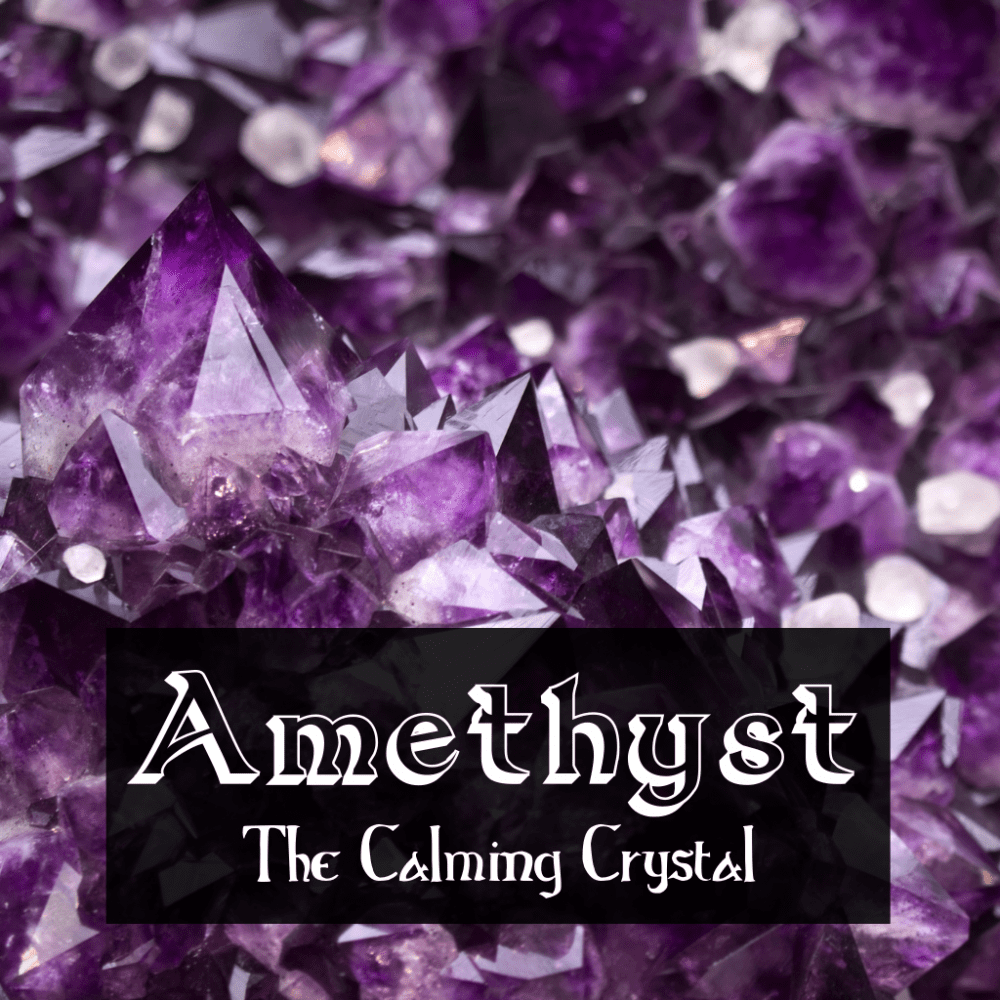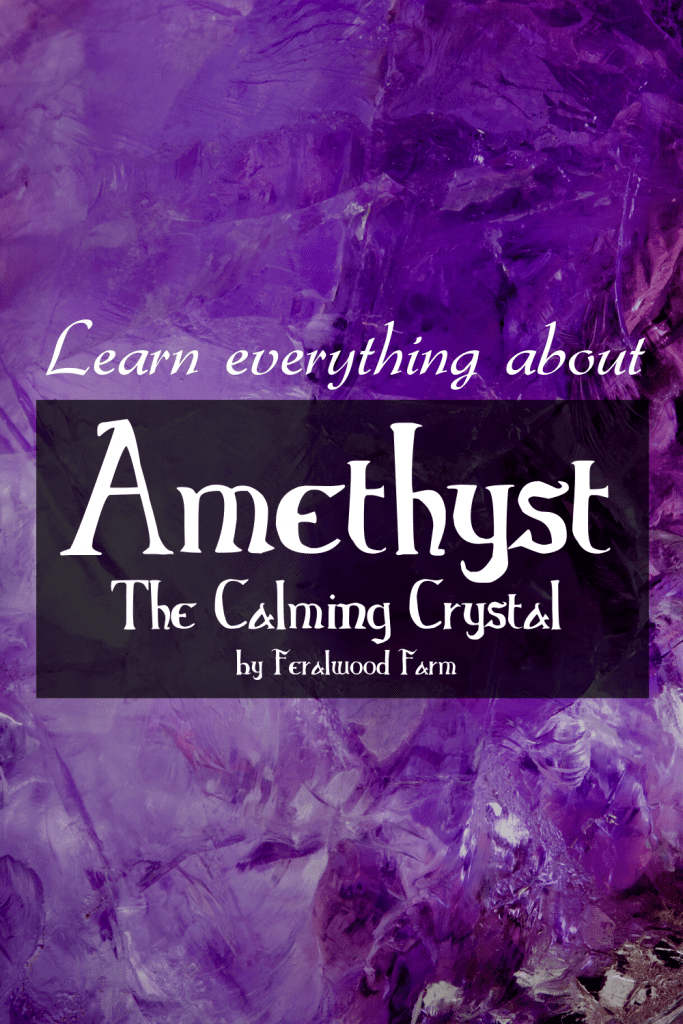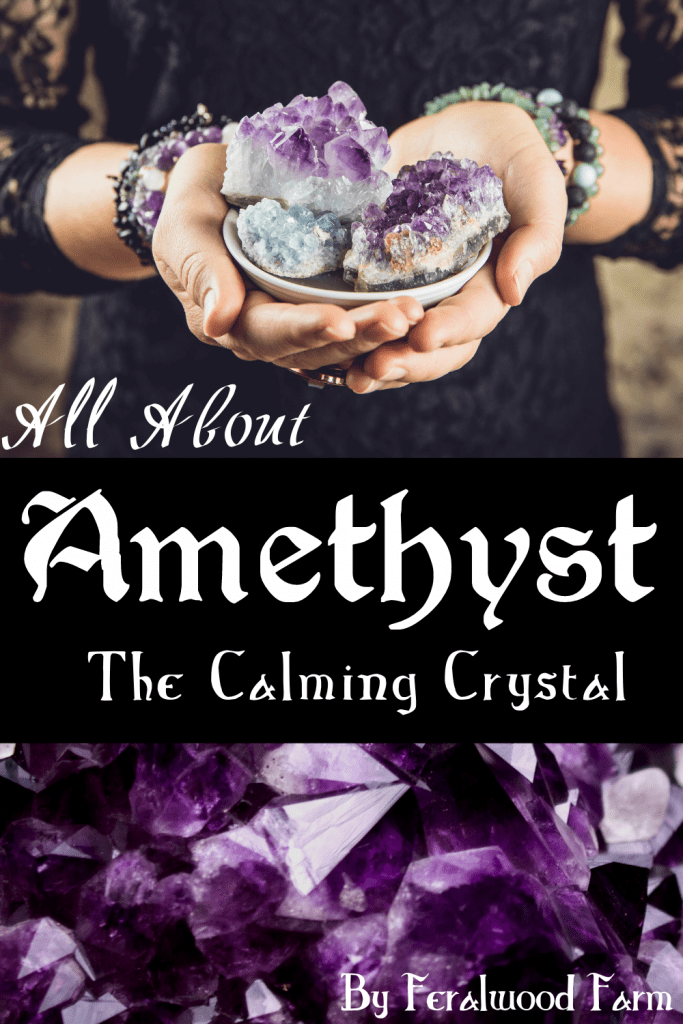
Learn about the crystal Amethyst. What is it, how to identify it, common folklore, metaphysical uses, correspondences, and more!
This post may contain affiliate links and I may earn a small commission when you click on the links at no additional cost to you! Thank you in advance for helping to support Feralwood Farm.
What is Amethyst?
A member of the Quartz family of minerals, amethyst is known as a Silicate mineral because it is primarily made up of silica. This crystal gets its purple color from traces of iron and aluminum When iron and aluminum combine with silicon dioxide in the presence of gamma rays, the crystal’s color can change to shades of purple. The intensity and shade of the purple color depend on the amount of iron and aluminum present in the crystal, as well as other factors such as the crystal’s environment and the duration of its exposure to gamma rays.
The name Amethyst comes from the Greek word ‘amethystos’ meaning ” not intoxicate”, as it was believed to prevent one from becoming drunk.
Locations where Amethyst is Found:
This crystal can be found naturally in the following locations:
- Sri Lanka
- Brazil
- Bolivia
- Zambia
- Canada
- Spain
- Russia
- Afghanistan
- South Korea
- Mexico
- United States
- Argentina
Amethyst can also be lab-grown by a synthesis method known as hydrothermal growth (essentially growing crystals inside a high-pressure autoclave). These produced crystals often imitate high quality amethyst, and its chemical and physical properties are exactly the same its naturally found counterpart.

Similar Crystals or Variants
Amethyst, as part of the Quartz family, has many similar or related minerals. This crystal is also commonly modified using human processes to create different varieties. Here are some of the more popular ones that you might come across or add to your crystal wish list!

Pink Amethyst is a type of amethyst that has a pink or lavender hue, and it is a relatively new discovery in the gemstone world. The pink color in amethyst is caused by the presence of iron and manganese, which are trace elements that give the crystal its characteristic pink color.
Citrine is a much fairly rare yellow form of quartz when found naturally. However sometimes Amethyst crystals are heated-treated to achieve a yellowish-brown coloration and sold as Citrine crystals.


Chevron Amethyst is a type of amethyst that features distinct, white chevron-shaped patterns or bands that cut across the crystal’s purple background. The unique patterns in chevron amethyst are formed through a combination of the crystal’s growth patterns and changes in temperature and pressure during its formation.
Ametrine is a type of quartz crystal that naturally occurs as a blend of both amethyst and citrine, displaying both purple and yellow-orange color zones in a single crystal. This crystal is highly valued for its blend of healing properties; combining the spiritual and mental clarity of citrine with the calming and intuition-enhancing properties of amethyst in a single crystal.


Amegreen is a type of quartz crystal that is a combination of amethyst and prasiolite (also known as green quartz), featuring bands of purple and green colors in a single crystal. This is believed to enhance the crystal’s metaphysical properties: promoting spiritual growth, emotional healing, and inner peace while also grounding and balancing one’s energy.
Black Amethyst is a variety of amethyst that displays a darker, almost black hue due to the presence of iron and other trace minerals, while still retaining the spiritual properties associated with traditional purple amethyst crystals. This crystal is often used for grounding, protection, and releasing negative energy.


Angel Aura Amethyst is a type of amethyst crystal that has been treated with a thin layer of platinum and silver, giving it a unique iridescent rainbow-like sheen that resembles the colors of the aurora borealis.

Geological Identification of Amethyst
- Color – purple, violet, dark purple
- Transparency:
- Luster – vitreous/glassy
- Cleavage – none
- Fracture – conchoidal
- Hardness – 7 (although can be lower in impure specimens)
- Streak – white or colorless
- Chemical Formula: SiO₂

Quality Indicators for Amethyst
The quality and value of an amethyst specimen are typically determined by a combination of factors, including color, clarity, cut, size, and origin.
The most prized amethyst crystals are a deep and vivid purple, with a uniform color and few inclusions or blemishes. Larger crystals are generally more valuable than smaller ones, and well-cut amethysts with symmetrical and precise facets are also more desirable.
The country of origin can also affect the value of amethyst, with some locations producing higher quality crystals than others. For example, amethyst from Zambia is known for its deep, rich color and high clarity, and is often considered more valuable than amethyst from other locations.

Crystal Care
Sun Exposure: May fade in tone if left overexposed to light sources, including the Sun
Water Exposure: This crystal is water-safe, however it is not recommend for salt water as it can damage the surface of the crystal and cause it to fade or lose its luster over time.
How to Clean this Crystal: Best cleaned with warm, sudsy water, and a tightly woven microfiber or other soft cloth.

Amethyst Correspondences
- Chakras – Third Eye Chakra, Crown Chakra
- Zodiac – Virgo, Sagittarius, Capricorn, Aquarius, Pisces
- Planet – Jupiter
- Element – Air
- Vibration – Number 3
- Day of the Week: Wednesday
- Deities: Dionysus, Rhea, Hermes
- Body: Hormone Production, Immune System
Metaphysical Properties
- Reported to help open a person’s third eye.
- These crystals are believed to assist with spiritual awakening
Folklore & Fun Facts
- Ancient Greeks believed this crystal would protect its owner from becoming drunk, and would often wear them while drinking or carve them into drinking vessels.
- There is a Greek myth of Rhea presenting Dionysus with this stone in The Dionysiaca
- Medieval European soldiers wore amethyst amulets for protection in battle
- In Tibetan culture, amethyst is considered sacred to the Buddha and often prayer beads are crafted from it
- Ancient Egyptians wore jewelry with this crystal to protect against guit and fear.
- Birthstone for the month of February
- Zodiac birthstone for Aquarius
- This crystal often adorned the crowns of royalty in Britain and Russia
- In Judaism the amethyst is believe to cause powerful dreams, symbolizes one of the 12 Tribes of Israel, and was placed on the breastplate of the high priest, Aaron.

Magickal Workings to Try with Amethyst
While Amethyst is heavily associated with calming and intuition, it has many other valuable properties that lend itself to aiding in your craft. Try including it in any of the following workings:
- Peace
- Serenity
- Calm
- Tranquility
- Protection
- Cleansing
- Sobriety
- Focus
- Motivation
- Spiritual Awareness
- Psychic Abilities
- Balance
- Communication
- Dream Work
- Sleep
- Protection from Nightmares
- Inspiration
- Love
More on Crystals
Read the rest of the Crystal Compendium here!
Pin it for Later
Did you know I use Canva to make all the graphics I use here on my website? Click here to try it out for yourself!


Leave a Reply